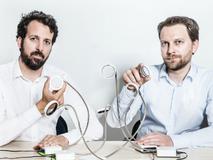Better and brighter light
11.02.2016
Fewer LED lighting in the future, more L.E.S.S. lighting. This is the objective of the 2012 Venture Kick winner L.E.S.S. in a nutshell. It has developed an entirely new lighting technology called ”Light Efficient SystemS“ or L.E.S.S. for short. This technology is far superior in many respects to the LED lights that have supplanted conventional light bulbs in the market. If the startup prevails, it might spell lights out for LED lighting before too long."
 L.E.S.S. co-founders Simon Rivier and Yann Tissot plan to employ more than 200 people in 5 years' time.
|
Our aim is to replace LEDs with L.E.S.S.“, explains CEO Yann Tissot. It might sound ambitious, but it could succeed due to the disadvantages of LED lighting: LED lights require a relatively large amount of space and do not illuminate areas evenly. And although they are more energy-efficient than light bulbs, they still leave much to be desired: 60 % of the electrical power is converted into heat rather than light when integrated into an illumination system.
The alternative technology of L.E.S.S. is composed of a single nanostructured optical fiber which generates brighter and more evenly distributed light than LED-based illumination systems. Moreover, this fiber requires much less integration space.
The technology could serve many different markets worth billions such as new screens for laptops or tablets, camera vision, watchmaking, medical technology and automotive lighting. The startup has already found its first customers. Its light is installed in “inspection lamps” used for the purpose of quality control in the precision micro-engineering and electronics sector. Several Swiss watch manufacturers are now turning to the new optical fibers from Lausanne, as are companies in Germany and Japan, such as Hitachi.
Billion dollar markets
The addressable market on which L.E.S.S. is setting its sights is worth over CHF 12 billion. For the consumer electronics segment, the startup needs to produce thousands of units to enter the test and integration phases. Thus, the company successfully completed a CHF 3 million financing round in spring 2015 in order to set up a first production line. A few months later, it was elected Switzerland’s No. 1 startup by the 2015 TOP100 Swiss Startups Award. Now, the objective of L.E.S.S. is to gradually ramp up its production capacities. Next year’s production forecast is set at 10,000 units, followed by 100,000 at the end of 2017 and over a million at the end of 2018. The objective is to break even by 2017 at the latest. Its co-founders estimate that in five years’ time, they will employ more than 200 people and achieve a sales volume in the double-digit million range. The headquarters are set to remain in Lausanne with offices in Asia and the USA.
The alternative technology of L.E.S.S. is composed of a single nanostructured optical fiber which generates brighter and more evenly distributed light than LED-based illumination systems. Moreover, this fiber requires much less integration space.
The technology could serve many different markets worth billions such as new screens for laptops or tablets, camera vision, watchmaking, medical technology and automotive lighting. The startup has already found its first customers. Its light is installed in “inspection lamps” used for the purpose of quality control in the precision micro-engineering and electronics sector. Several Swiss watch manufacturers are now turning to the new optical fibers from Lausanne, as are companies in Germany and Japan, such as Hitachi.
Billion dollar markets
The addressable market on which L.E.S.S. is setting its sights is worth over CHF 12 billion. For the consumer electronics segment, the startup needs to produce thousands of units to enter the test and integration phases. Thus, the company successfully completed a CHF 3 million financing round in spring 2015 in order to set up a first production line. A few months later, it was elected Switzerland’s No. 1 startup by the 2015 TOP100 Swiss Startups Award. Now, the objective of L.E.S.S. is to gradually ramp up its production capacities. Next year’s production forecast is set at 10,000 units, followed by 100,000 at the end of 2017 and over a million at the end of 2018. The objective is to break even by 2017 at the latest. Its co-founders estimate that in five years’ time, they will employ more than 200 people and achieve a sales volume in the double-digit million range. The headquarters are set to remain in Lausanne with offices in Asia and the USA.


